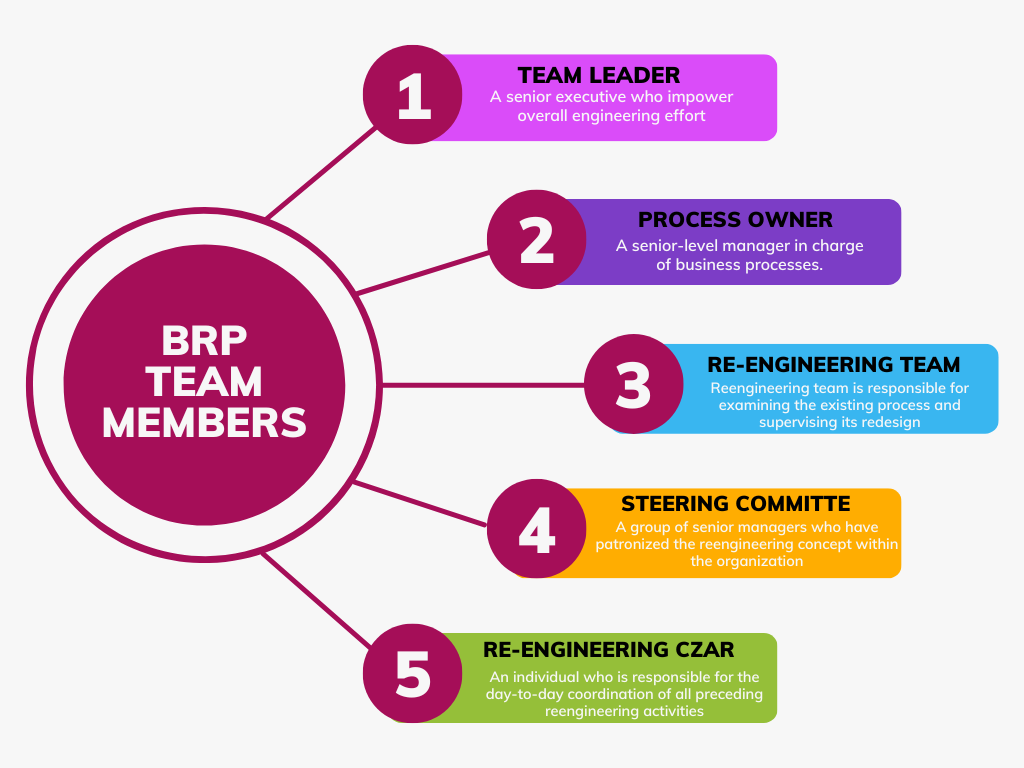Business Process Re-engineering

Outline
What is Business Process Re-engineering?
Phases of Business Process Re-engineering
Is Business Process Re-engineering (BPR) the same as Business Process Improvement (BPI)?
When is Business Process Re-engineering required?
Principles of Business Process Reengineering
Business Process Reengineering methodologies
BPR stands for Business Process Re-engineering. Business process reengineering is a management strategy and a systematic approach to improve product quality and reduce organizational cost, service and speed.
It is an act of recreating a core business process and was pioneered in the early 1990s.
BPR services involve the analysis and transformation of several major components of a business. These include;
- Strategy
- Organization
- Process
- Technology
- Culture
This process is administered by a business advisory and consulting firm.
Why should you do it?
Business process reengineering (BPR) helps organizations reimagine their existing processes and redesign them to achieve extraordinary results.
Phases of Business Process Reengineering
BPR includes three phases; analysis phase, design phase, and implementation phase. It is also referred to as business process redesign, business process change management, and business transformation.
Is business process reengineering (BPR) the same as business process improvement (BPI)?
Business Process Reengineering(BPR) sounds the same as Business Process Improvement(BPI) but there are some basic differences. BPI is about adjusting a few rules here and there. But BPR is a spontaneous approach to looking beyond boundaries. BPI is an incremental setup while BPR is a broader picture. BPI is about upgrading an exhaust system and BPR is about rethinking the entire way the drain is handled.
When is business process reengineering required?
The need for Business Process Reengineering reflects in the following ways
- Profitability is falling
- Struggle with cash flow
- Customer complaints are raising
- Refund requests
- Turnover is high
- Inventory levels are rising

Principles of Business Process Reengineering
Following are the seven principles of business process reengineering.
- Align around customers, not tasks
- Identify organization processes and categorize them in order of redesign magnitude
- Embody information processing work into the real work
- Handle geographically scattered resources
- Link analogous activities in the workflow
- Build control into the process
- Bring in all the information once
Roles of BPR team members
The revolutionary change supported by BPR requires commitment from the company’s top executives.
BPR execution uses a team approach and a reflection of their roles is given below;

Team leader:
A senior executive who has visualized and empowered the overall reengineering effort. The team leader is responsible for appointing the process owner.
Process owner:
A senior-level manager in charge of business processes. The process owner assembles the team to reengineer the process.
Reengineering team:
Reengineering team consists of insiders and outsiders. Insiders’ work involves the process of being re-engineered. This team is responsible for examining the existing process and supervising its redesign.
Steering committee:
It is a group of senior managers who have patronized the reengineering concept within the organization. They set specific goals for process improvement. The steering committee is led by the team leader and is responsible for helping the process owner make a decision regarding priorities.
Reengineering czar
: An individual who is responsible for the day-to-day coordination of all preceding reengineering activities. The czar’s responsibility is to be an accelerator and develop the techniques the organization uses to reengineer workflow.
Business Process Reengineering methodologies
Many business process reengineering methodologies are known and given below;
- Hammer/Champy methodology
- The Davenport methodology
- Manganelli/Klein methodology
- Kodal methodology
Critical steps of business process reengineering (BPR)
Business Process Reengineering is not an easy task. It is a proven methodology that allows redesigning of associated systems and structures.
Identify the need for change and identify what you want
What do you expect after the execution of the business workflow? First, decide what and how you want your business outcome to work. If you’re a small startup, this can be a piece of cake. For example, if you are looking to get deliveries to customers within a specific timeframe, see how you can speed up this process.
Define the current state
Complete all the steps involved in the work process and find where errors might bring down business efficiency.
Identify gaps
Set up key performance indicators that give you an idea of being far or close to your business goals. Look how long it takes to complete the programmed steps.
Select a test case
Look for vital processes impacting your process efficiency. Then come up with a future plan to help to achieve your goals.
Develop and test the hypothesis
Make new workflows and procedures, and communicate to relevant stakeholders. Create test scenarios and implement them to check their relevance.
Implement process and evaluate the performance
Track your new process performance and assess the impacts in comparison to previous business workflows using KPIs. Come up with clear strategic improvements, and new challenging ideas and evaluate your overall performance.
Benefits of business process reengineering (BPR)
Business Process Reengineering is a huge struggle and has many benefits which are described below.
1. Increase efficiency:
With the elimination of redundancy in operations and adjusting processes, managing things will be easy and fast. It improves efficiency overall.
2. Refined and simplified operations:
At the end of the entire process of business reengineering, efforts become inducted toward organizational objectives. Business is left with simplified operations and all those things are cut down that slow business efficiency.
3. Transparency of purpose:
The first step of BPR execution is to have solid control over the prevailing state of your business processes. It ensures that you are implementing the right things and reducing the risk of future costly mistakes.
4. Better results and products:
Greater efficiency and focused goals empower you and your employees to put more light on building a healthy relationship with customers through the refined process.
5. Business maximized Rate Of Investment(ROI):
The steps mentioned earlier ultimately increase the ROI of the business



You May Also Like

Working Capital Management
Working capital management is a business strategy planned to ensure that a company operates smoothly by monitoring its current assets and liabilities to their effective use and maintaining sufficient cash flow to meet...

Treasury Management
Treasury management is the management of enterprise holding. It is a key component of business operations. In the business landscape, the importance of treasury management cannot be denied. Treasury...

Investment Dashboard
The investment dashboard is an integrated panel for tracking, reconsidering, and scaling the performance of investments of the organization. This panel allows the monitoring of investment records following fixed...

Standard Operating Procedures (SOPs)
A Standard Operating Procedure (SOP) is a set of written instructions that describes activities necessary to complete the task under industry regulations. A Standard Operating Procedure is a document...
